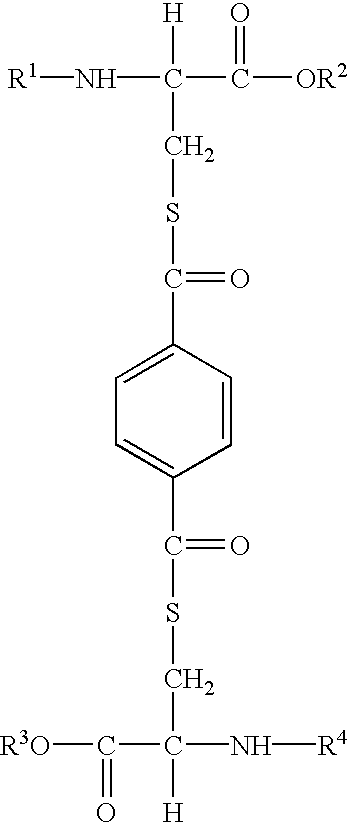Methods for producing, films comprising, and methods for using heterogenous crosslinked protein networks
a technology of crosslinked protein and network, applied in the direction of peptides, cytokeratin, powder delivery, etc., can solve the problems of relatively limited chemical and engineering properties of keratin proteins, and achieve the effect of reducing the number of keratin proteins
- Summary
- Abstract
- Description
- Claims
- Application Information
AI Technical Summary
Problems solved by technology
Method used
Image
Examples
example 1
[0068]Reduced, HMWK was prepared by placing 40 g of clean, dry human hair into a 1000 mL wide mouth glass reactor. 800 mL of a 0.8M solution of thioglycolic acid at pH 10.2 (adjusted with potassium hydroxide) was added and the mixture was stirred at room temperature under a nitrogen atmosphere for 18 hours. The solution was filtered and the liquid discarded. The hair was rinsed with copious amounts of deionized (DI) water, then placed back into the reactor. 400 mL of a 7M urea solution was added and the mixture was stirred at room temperature under a nitrogen atmosphere for 24 hours. After urea extraction, the solids were separated from the liquid by centrifugation. The liquid was added dropwise to a 10-fold volume excess of ethanol, thereby forming a keratin precipitate. The precipitated keratins were isolated by filtration and dried under vacuum. The resulting HMWK powder was ground by hand using a mortar and pestle.
example 2
[0069]500 g of clean, dry human hair was placed in a 12000 mL round bottom flask. 8350 mL of 1 weight / volume percent of hydrogen peroxide was added and the reaction heated to reflux for 180 minutes. The hair was separated from the liquid by filtration and the liquid discarded. The hair was rinsed with copious amounts of water and allowed to air dry. 100 g of the dried, oxidized hair was placed in a 2000 mL round bottom flask. 1000 mL of 1M thioglycolic acid at pH 9 (adjusted with ammonium hydroxide) was added and the mixture was heated to 60° C. under a nitrogen atmosphere for 24 hours. After reductive extraction, the solids were separated from the liquid by centrifugation. The liquid was added dropwise to a 8-fold volume excess of ethanol, thereby forming a keratin precipitate. The precipitated HMWK keratins were isolated by filtration and dried under vacuum.
[0070]A solution was prepared by mixing 2 g of HMWK with 1 mL of 30% ammonium hydroxide and 10 mL of dimethyl sulfoxide. The ...
example 3
[0071]4.5 g of the HMWK sample from Example 2 was dissolved in 2.25 mL of 30% ammonium hydroxide and 22.5 mL of dimethyl sulfoxide by heating to ca. 75° C. and stirred. The solution was split into 9 separate vials and used to prepare the solutions described in the following Table.
[0072]
PhthalicTerephthalicAnhydrideDER ™ 332Sodium AcetateSampleAcid (grams)(grams)Resin (grams)Catalyst (grams)1a————(control)2a0.025——0.0052b0.050——0.0053a—0.025—0.0053b—0.050—0.0054a——0.025—4b——0.050—
The solutions were poured into separate petri dishes and placed under a heat lamp for ca. 240 minutes. After curing, a small piece of each elastomer was immersed in a pH 7 aqueous buffer solution. After exposure to aqueous buffer for 48 hours, elastomers 1a, 2a, 2b, 3a, and 3b had disintegrated and partially dissolved. After 6 days, elastomers 4a and 4b remained intact.
PUM
| Property | Measurement | Unit |
|---|---|---|
| molecular weight | aaaaa | aaaaa |
| molecular weight | aaaaa | aaaaa |
| temperature | aaaaa | aaaaa |
Abstract
Description
Claims
Application Information
 Login to View More
Login to View More - R&D
- Intellectual Property
- Life Sciences
- Materials
- Tech Scout
- Unparalleled Data Quality
- Higher Quality Content
- 60% Fewer Hallucinations
Browse by: Latest US Patents, China's latest patents, Technical Efficacy Thesaurus, Application Domain, Technology Topic, Popular Technical Reports.
© 2025 PatSnap. All rights reserved.Legal|Privacy policy|Modern Slavery Act Transparency Statement|Sitemap|About US| Contact US: help@patsnap.com



